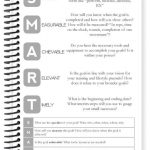SMART Goals can be one of the most powerful tools in your achievement toolbox because they give you a framework through which you can set out the goals and criteria for achievement. By going through the process of making your goal SMART, you will learn to limit each goal’s scope and make sure they truly fit for you. You will also be forced to think about the steps and habits necessary to create meaningful progress that will help you in the short term and lead to longer term success.
SMART Goals are a mnemonic acronym that stand for
- Specfic
- Measureable
- Achievable
- Relevant
- Timely
We’ve created a series of pages in our workout journals to help you keep track of your SMART Goals. It comes in all of the journals except for the STRICT and NOTEBOOK, and you can add it to a Build-a-Journal.
Add it to a journal or Build-a-Journal
Take a closer look by clicking on the thumbnails.
Let’s go over how to make a goal SMART:
SMART Goals – Specific
You want your goal to be as focused in as possible, so what is specific about your goal?
Try not to make it too broad because you will get lost in trying different ways to fulfill it. By making it specific you are better able to figure out the criteria which will determine success and limit the scope of the goal to something you can actually do.
Setting a goal to run a marathon is not as useful as saying you want to increase your running by 1 mile each week for the next 26 weeks. Be as specific as possible.
Use questions from the How, What, When, Why, Who, Where family to help you break it down:
What is my desired end benefit?
What are frequent things I can do to help me get there?
How can I complete this goal?
How will it affect me?
Who can I ask for help?
Why is it important?
SMART Goals – Measurable
SMART Goals are measurable because without that measurement you will not be able to keep track of your progress or forecast a finish to your effort. Also, by measuring your SMART Goals, and because you will see success along the way, you are far more likely to be motivated by that success, and continue with your efforts.
Going back to our marathon example, measuring your split times, or the distance each week would be measurable metrics helpful to that goal.
Here are a few question starters to get you making measurable SMART Goals
How much…?
How many…?
How far…?
How will I know it is finished?
What are the benchmarks for progress?
SMART Goals – Achievable
SMART Goals that are achievable make a lot more sense than ones that you have no chance of completing. While it is good to stretch yourself, by making your goal realistic and attainable, especially in the short term, you automatically rein in your goal. By starting out with the mindset that your goal must be accomplished, you mentally put yourself on a trajectory to choose a reasonable goal.
With our marathon goal we are choosing a distance we’re ready for because we’ve done 10k’s and Marathons before. If I was just starting running, it probably wouldn’t be a good idea. We’ve also got access to coaches and the time in the week to commit.
Here are a few questions to make sure your goal stays achievable:
How can I accomplish my goal?
Is this goal reasonable for where I am right now?
Do I have the time/energy in my schedule to achieve this goal? Where would I put it?
SMART Goals – Relevant
SMART Goals become relevant when they are created relative to where you are at this very moment. It doesn’t do a lot of good to make a goal that your future self in 5 years will be able to achieve. Instead, you should make sure your goals can be completed by the you of today, with your strengths and weaknesses as they exist right now. This acceptance of your current state, whether good or bad, allows you to get past the goals your perfect self could complete, and focus on the ones you can complete as an imperfect you. Making your goals relevant constrains them to the near term outcome you are seeking.
The idea of a goal being relevant also pertains to making sure it fits in with your other goals and resources. If it doesn’t match up well with your schedule, time, energy or people who can help you, it might not be the right goal for right now.
Our marathon goal doesn’t make a whole lot of sense if we are nursing a broken leg, but it does make a lot of sense if we’ve already done a 10k or half-marathon and we’re ready for the next push.
Here are some questions to make sure your goal is relevant:
Is this worthwhile?
Is there anything that is going to really get in the way of achieving this goal?
Does this match up with my other goals?
How much energy can I devote to this? How much energy will it need?
Is high-level help easy to access?
SMART Goals – Timely
Your SMART Goals should be timely, both because you should be able to complete it and so you can set a deadline within which to structure your progress. While it can be difficult to accurately predict how much you can get done within any time period, especially with stretch goals, giving yourself the deadline allows you to work backwards and figure out the steps it will take and timeline of your progress.
Also, having a timeline to your goal can help it maintain its priority over your daily tasks.
With our marathon goal we decided on a gradual buildup of adding 1 mile/wk for 26 weeks. This gives us a clear end date and weekly steps to achieve it.
Here are some questions to help with the timeliness:
When is the deadline?
How often will I work on my goal?
What can I do each day?
When to use SMART Goals?
You don’t need to use SMART Goals for each of your goals, but the ones that are most important to you could use the extra focus and attention the SMART Goal framework brings. Reserve the SMART Goals for goals that mean a lot to you and invest the time to give you the best chance of completing them.




